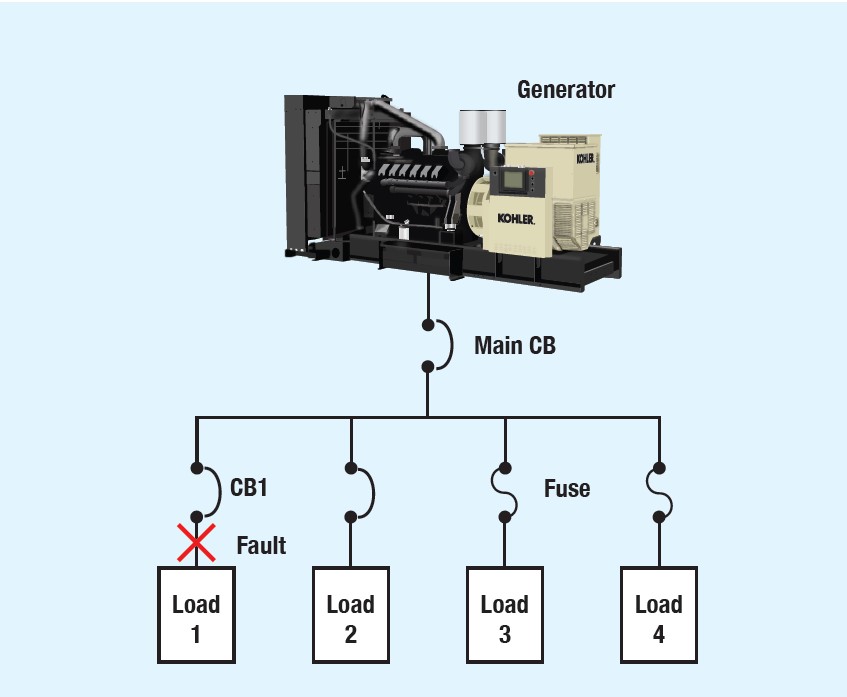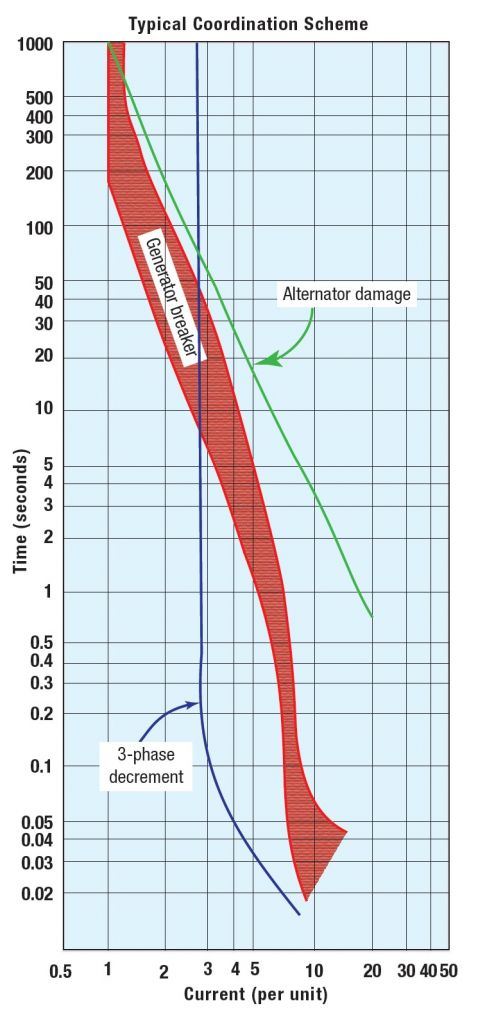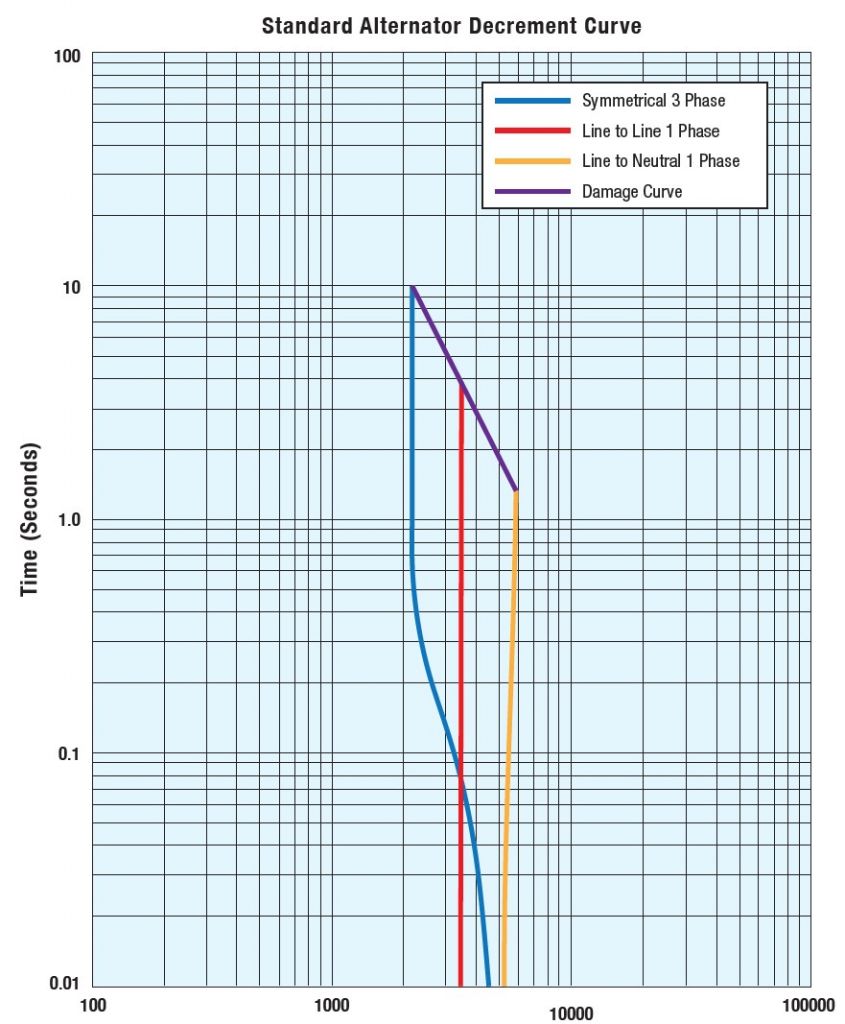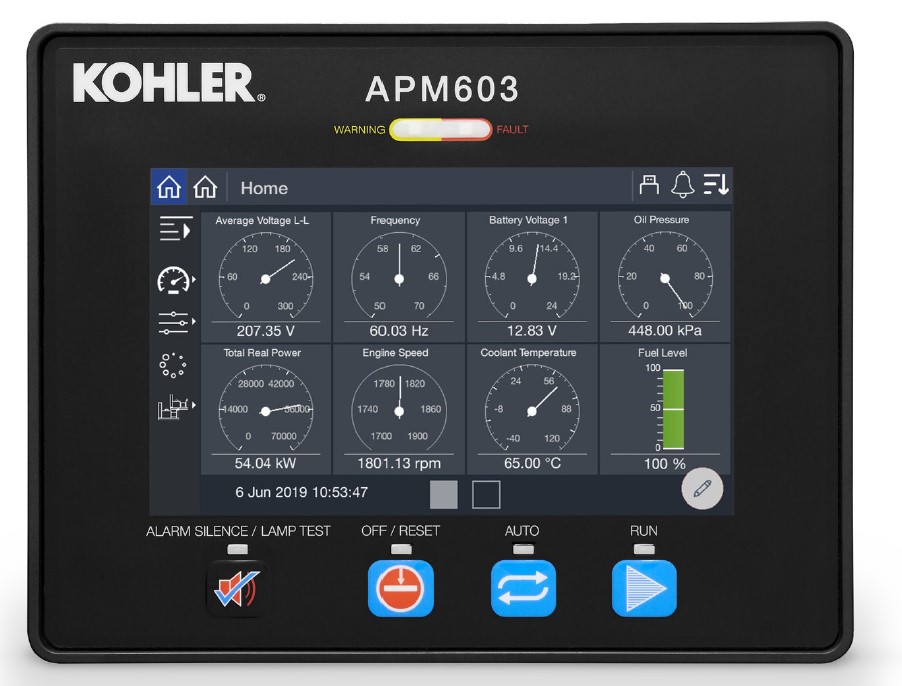Protecting power generation equipment from damage due to abnormal conditions that exceed output ratings is paramount. The National Electric Code (NEC) mandates the coordination of protective devices in circuits powered by generators, especially for life safety loads. Utilizing voltage regulation controls to apply full excitation to the generator field during fault conditions can simplify coordination.
Overcurrent protection involves any current that exceeds the generator’s rating. These conditions typically stem from overloads, short circuits, or ground faults. Without overcurrent protection, the entire system can be compromised, potential loss of crucial life safety circuits due to a distant fault, as shown in Figure 1.
Common protective devices include fuses and circuit breakers:
Fuses act quickly and are cost-effective, but they require replacement after the filament inside blows during a trip.
Circuit breakers, on the other hand, can be reset after tripping and have multiple options to determine reaction time in the event of a fault, making them safer than fuses. The most suitable circuit breakers for these conditions have inverse time trip characteristics – the higher the current, the shorter the time before the breaker trips. Generally, except for smaller branch breakers, the reliance is on the thermal or electronic section rather than the magnetic section. These breakers feature an Amperes Interrupting Capacity (AIC) rating, denoting the maximum tripping current they can manage without damaging the equipment.

EXCITATION SUPPORT. EXCITATION FAULT CHARACTERISTICS.
A standard generator set without specialized field excitation maintenance provisions will experience a complete output collapse during a near-solid fault. The instantaneous section of generator line circuit breakers is unlikely to react since generators typically exhibit less than five times their rated current during short circuits. Ground faults or short circuits on load lines cause the generator voltage to drop, prompting the digital voltage regulator to apply full excitation to the generator field, which is typically two to three times the full-load excitation. Fault location and severity can lead to short-circuit currents up to 600% of the rated current, sufficient to trip branch-circuit fuses or circuit breakers.
WITHOUT EXCITATION SUPPORT
Without excitation support, short-circuit current falls to zero almost instantly. Enhanced field forcing through a permanent magnet (PMG) or auxiliary winding design allows the voltage regulator to recover quicker, based on the generator’s internal reactances.
GENERATOR CIRCUIT BREAKER PROTECTION
The generator’s ability to supply substantial fault currents could damage the alternator without overcurrent protection devices. Thus, a generator circuit breaker is essential to interrupt overload (including fault conditions) current after a specific delay, allowing downstream devices to operate or trip nearest to the fault before damaging the generator. KOHLER® generator sets can endure 300% of rated current for 10 seconds during a short circuit.
SELECTIVE COORDINATION STUDY
Figure 2 illustrates a typical coordination scheme, showing current versus time. A complete coordination study requires understanding the interplay of these three curves:
1. Alternator damage curve aligned with alternator protection.
2. Generator breaker curve indicating the tripping window.
3. Alternator decrement curves for generated current.
Each overcurrent protection device time delay increases from the load to the source. A selective coordination study is essential for determining proper time delays for each device between the power source and the load.
Figure 2

ALTERNATOR DECREMENT CURVES
STANDARD ALTERNATOR DECREMENT CURVE
Decrement curves illustrate generator current during short circuits made at the generator terminals, indicating the maximum current the generator can provide for coordinated protection system development. Figure 3 shows a standard alternator decrement curve. Real-world applications usually do not reach the maximum due to load line impedance and potentially reduced generator speed. Three curves are provided: three-phase, line-to-line, and line-to-neutral faults.

THREE PHASE CURVE
The three-phase curve is typically used by engineers for conservative planning in selective coordination studies. However, line-to-line and line-to-ground faults are more common in practice. The curves conclude at the thermal capability limit or damage curve. The protection system must prevent any current and time combination beyond this line, implying the need for an inverse-time characteristic to define the alternator’s thermal limits.
CONTROLLER PROTECTION
KOHLER® GENERATOR CONTROLLERS
Kohler generator controllers come with integral alternator thermal protection, limiting the delivered current below the damage curve. The generator breaker protects downstream devices. Figure 4 shows the APM603 controller, which includes features like current-limiting settings for alternator and fault protection. With an integrated voltage regulator, the APM603 meticulously controls alternator excitation, utilizing on-board configurations for maximum generator protection.(Figure 4)

APM603 FEATURES
The APM603 also includes Energy Reduction Maintenance Switching (ERMS) capability, classifying it as an overcurrent protective device per NEC 240.87 Arc Energy Reduction.
MAINTENANCE MODE FUNCTION
The Maintenance Mode function allows intuitive configuration of instantaneous current overload events without altering software. Customers can set these limits based on load profiles, providing a warning when the instantaneous trip or maintenance mode is enabled, preventing the system from being in the “ready” mode.
FINAL THOUGHTS
Generators typically offer limited fault current capability compared to utility services. Very high quality generators such as Kohler generators provides crucial overcurrent protection support for reliable generator operation, essential in designing safe and effective backup power systems. NEC mandates a selective coordination study for emergency systems. Decrement current curves are vital tools for these studies. KOHLER generator circuit breakers and decrement curve information on SKM Power Tools assist engineers in their coordination efforts.


